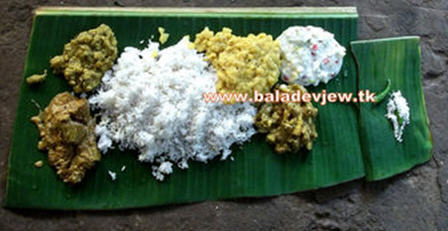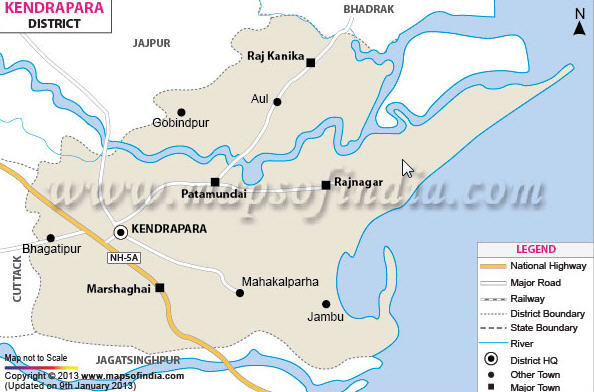
Baladev Jeu Temple is situated in Ichhapur (Tulasi Khetra), kendrapara, odisha. Baladev jeu temple is a very famous temple of Odisha and Balarama is its main divinity. However, Jagannath and Subhadhra are also worshipped in the ratna sinhasan in the main temple. A deity of tulasi as a goddess in a seated position is also present after the sacred seven steps.
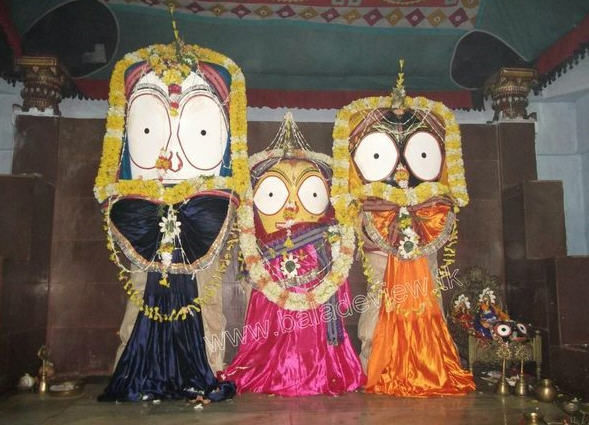
Tulasi Kshetra – Kendrapara is one of the five holy Kshetras of Orissa. It houses the temple of Lord Baladeva Jeu in the heart of this Kshetra. The same rites and rituals of Lord Jagannath at Puri are generally followed here which makes Kendrapara equally attractive. It is only 95 Km away from the state capital Bhubaneswar. Literature like Brahma Tantra written by Vedavyas and Padma Purana speak the glory of this place. Here Lord Balabhadra married Tulasi, the daughter of the demon king Kandarasura and resided here secretly. So this place is called Tulasi Kshetra or Gupta Kshetra. It is also known as Brahma Kshatra, Kandarapadi or Kendarapada.
The deity holds club (Musala) in his right hand and plough in the left. Balabhadra is known as elder brother of Vasudeva. Rebati Raman, Talanka, Musali, Hali, Kamapal, Kalandi Vedan, Pralaghna, Achutagranja, Bala, Rohineya, Nilambara, Sirapani, Halayudha, Baladeva, Balarama and Sankarsana are the sixteen other names of Balabhadra.
History of the Place:
There are several stories surrounding Lord Baladeva Jeu at Kendrapara. Kandarasura, a demon king, destroyer of Yajnas (sacrifices), was ruling over the area surrounding Lalitagiri and Assia mountain ranges. Tulasi kshetra Mahatmya reveals that he lived near Lalitagiri – Alatigiri and was terrifying people. Lord Balabhadra defeated him in a fightand as a result of which he left the place, went to Kapilas mountain near Dhenkanal and lived in disguise in the nearest mountain ranges as he was an ardent devotee of Lord Siva. Lord Balabhadra thoroughly searched every nook and corner of the hill and lastly ploughed the hill with his plough (hala) as a result of which one perennial spring emerged from the hill, which is now called ‘Langal Siar Jharana’ (spring of the plough). After persuading him from Kapilas, Lord Balabhadra killed the wicked demon Kandarasura in a fight and threw his slain body all over nearby places by cutting it into pieces.
It is a popular belief among the local people that the scattered body was fallen at Asureswar, Balagandi, Kamar Khandi, Navi Khanda.These places are named after the head (Aswa Sira), trunk (Gandi of Aswa) waist (Kamar-Khanda) and navel (peice of Navi) of the demon Kandarasura respectively. It is also believed that the Siva temples of Swapneswar at Kantia, Lankeswara of Gualisingh, Bileswar of Kagal were founded by Baladeva over the face, neck and waist of the demon respectively, Balagandi, the place where the trunk of Kandarasura had fallen is called Kandara padi (Kendrapara). According to his name, the place name ‘Kandharapara’ or ‘Kendrapara’ has been derived.
Before killing the demon, Lord Balabhadra at first killed Madhudaitya, the chief military general of Kandarasura at Lalitagiri through his war weapon plough. The blood gushing out from the body of the general formed a river named Madhusagar (now Gobari river) which flow towards east by the side of Kandarasura Menhir and ultimately meet the sea.
Lord Balaram married Tulasi, the only daughter of Kandarasura on the 12th day of the bright fortnight in the month of Magha which is observed with pomp and ceremony every year as ‘Tulasi bibaha day’ (marriage day of Tulasi) in the Baladeva Jeu Temple, Kendrapara. The place where this marriage was performed is renamed as Tulasi Kshetra. The deity of Tulasi Devi is worshipped in a temple near village Gochha on the northern side of the road from Kendrapara to Ichhapur.
The Deity of Baladeva Jeu – It is said that after the departure of Lord Balarama to his own abode, he established himself as a deity to be worshipped here. This deity was worshipped by Devatas (demigods) at the door of Patalpuri which is identified with Lalitagiri in Dwapar Yuga. When Kali yuga appeared Buddha Dharma (Buddhism) spread over the area. At this time, this deity of Baladev jeu was hid in water of Madhusagar (river Gobari). After many years, a great devotee of Lord Balaram of the name Gopal Siddha Das, who was a cowherd boy discovered this deity of Balabhadra near Siddha Sarobar. Since then, this deity is worshipped at Kendrapara. The deity is also worshipped as Siddha Baladev Jeu after the name of Gopal Siddha Das, who discovered the deity for all people to worship. The present shrine of Siddha Baladeva Jeu was constructed during the Maratha rule in Orissa(1761 AD) by Maratha chief Janoji. The stone Deity of Lord Balabhadra and wooden deities of Jagannath, Subhadra and Sudarsan are all worshipped here according to the rituals of the temple in Lord Jagannath at Puri.
The Ratha Chariot:
The chariot on which the three Deities of Baladev Jeu
temple go out on Their yearly car festival is known as Brahma Taladhwaja Ratha. This is said to be the biggest chariot in the world. Every year, some parts of the chariot are built anew, unlike the chariots of Puri Car festival, which are completely rebuilt each year. When Sri Brahma Taladhwaja Ratha rolls out, it appears like a grand temple on wheels. Car festival (Rathyatra) of Lord Balabhadra in the Tulasi Kshetra is celebrated on the 2nd day of bright fortnight in the month of Asadha just like the Car festival of Puri.
i. 
Some of the specifications of the chariot:
Total no. of wheels: 14,
which signifies the 14 universes (bramhanda)
Height of the wheels: 6 feet 6 inches
Total no. of log pieces used: 1013
The height of the chariot: 65feet height of simhasana from ground level:
The number of axles (akha) are 7, which signifies the 7 elements.They are 12 feet six inches long.
Number of horses are four (2 black and 2 white). Names of the horses: Teevra, Ghora, Dirghashrama & Swarnanabha.
Rope of the chariot: Vasuki The covering of the chariot is of seven colours.Total no. of ropes:7 of 40 feet each.
The name of flag (neta): Unnani.
Divine attendants in front of the Chariot: Garuda & Hanuman. Gatekeepers ( Dwarapalas): Surya & Chandra In murdhi: Ketuprabha.
At the door: Rudra is the chariot Keeper (rakshak): Vasudev Sankarsan Side deities (parshwa devata): Harihar, Tripurari, Laxman, Siddha Vinayak, Nrusingha, Vasudev, Chamunda, Bhadrakali, Mangala, Banimangala, Bhairavi, Chakra Basulai, Natambar, Durga, Shesadeva. Besides this Rathyatra festival, the festival of Makar Sankranti, Mahabishuva Sankranti (Pana Sankranti), Chandan Jatra and Snana Purnima, Shravan Purnima (Baladeva Janma) and Maghasukla Dwadasi (Tulasi Bibaha) are some of the main festivals observed in the Baladeva Jeu temple at Kendrapara with devotion to Lord Baladeva : “Barsanam Bharata Shresthah Desanam Utkal Tatha, Utkale Shrestha Tirthani Krushnak Parvati Harah. Yatrayam Halayudha Gachheta Tulasi Kshetre Tisthatah, Utkale Pancha Khetrancha Badanti Muni Punga Bah.”(Brahma Tantra).
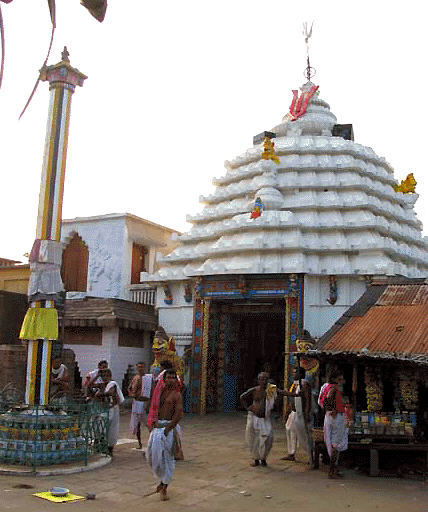
Offerings ( Dhupa)
Morning offering ( Sakala Dhupa) 9.00 AM to 10 AM
Offering at pre-noon (Madhhyanna Dhupa) 11.00 AM to 12 Noon
Rice offering ( Dwiprahara Dhupa/ Anna Dhupa) 2.30 PM to 3.30 PM
Offering at evening ( Sandhya Aarati Dhupa) 6.00 PM to 7.00 PM
Rice offering ( Nisankhudi Dhupa) 8.00 PM to 9.00 PM
Offering at night ( Badasinghar Dhupa) 9.30 PM 10.00 PM
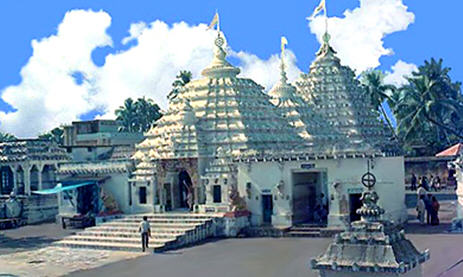
Architecture and Construction of Baladev Jeu temple:
Baladev jeu temple is constructed over an area of 2 acres of land. There are 2 parts in the total area, in one part, different temples are located and another part is a beautiful garden. There is a big boundary around the temple, which is 14 meters high. There are four main parts of Baladev Jeu Temple which are Sri Mandir, Natya Mandir, Bhoga Mandap and Mukhashala. The main temple height is 75 feet and width is 40 feet. The main temple has seven steps and heavy baulamalia stone are used in this temples construction. The other important parts of the temple are Garuda Stambha, Ratna Bhandar, Snana Mandap, Mukti Mandap, Jhulan Gruha, Laxmi Mandira, Anand Bazar, Bhairabi Mandir, NabaGraha Mandir, Kasi Biswanath, Astasambhu Mahadev, Sri Ram mandir, Sidheswar Mahadev, Mukti Mandap, Ganesh mandir, & Adhistati Devi tulasi temple.
Bhoga offering:
Different types of bhoga offerings are made by traditionally trained families, known as Supakara and Mekap, who are engaged solely in seva to the Deities. There are many historically famous preparations offered, among others, including: Baula Gaintha, Upana Pitha, Mithei, Chaurashi Vyanjana (84 vegetable curry), Makara Chaula, Bhaja,Ghia Anna, Dali, Phalamula (fruits), Dry sweets, Ghanavarta, Pura Kakara, Rasabali, Potali Pitha, Chipa Kakara, Karanji, Khaja, Magaja Ladoo, Dalimba, Khuduma, Nishkudi, Mutha Gaja, Tala, Chhena Chakata. Bhoga like “Rasabali” is famous in Baladeva Jeu temple.
